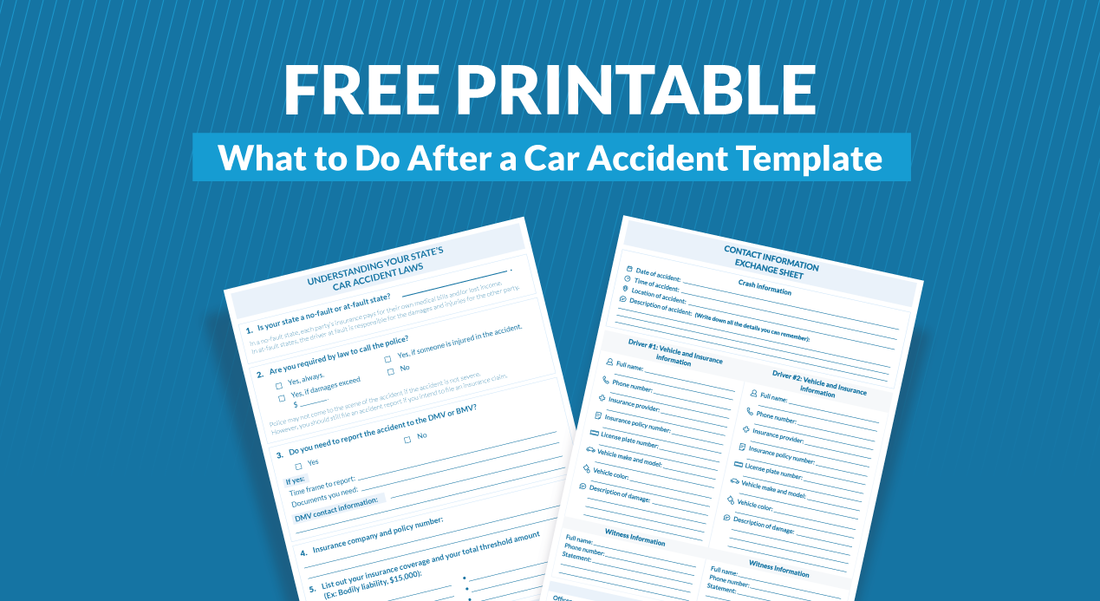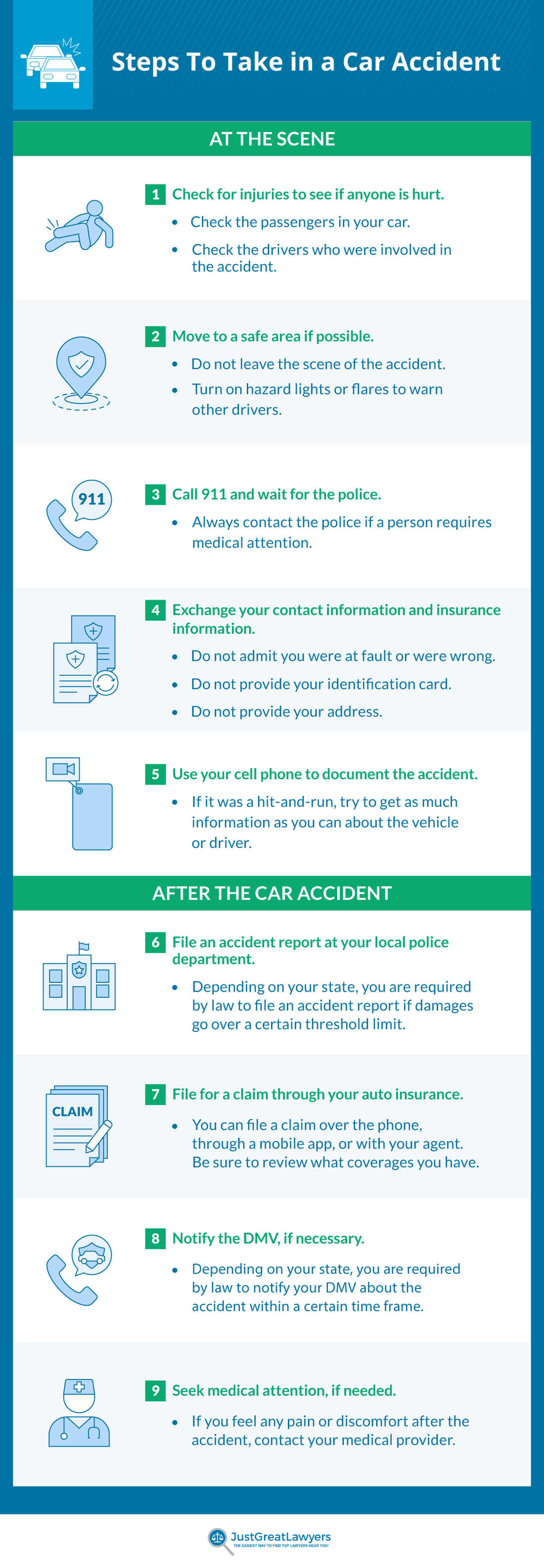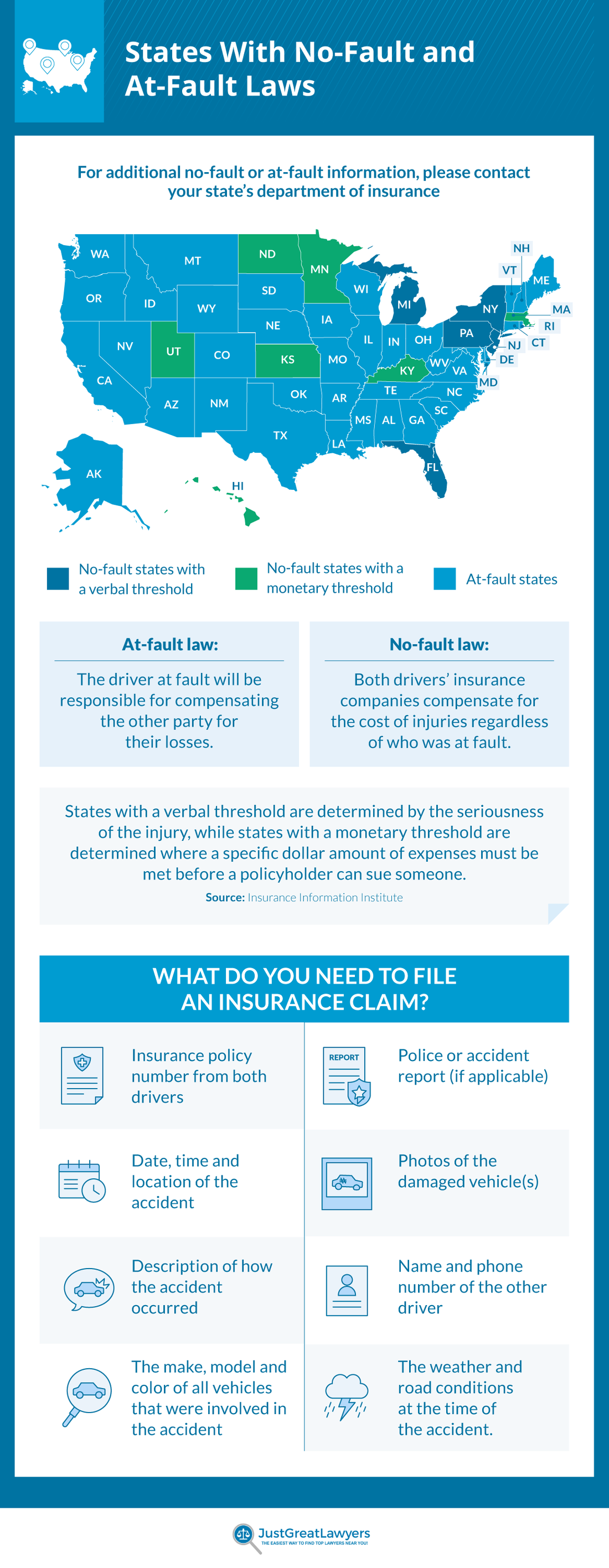Getting in a car accident can be stressful, even when it’s just a minor accident. You may find yourself wondering about vehicle damage, auto insurance, police reports and even medical bills if someone was hurt. Whether the accident was serious or minor, there are steps you can take to protect yourself and make any insurance claims easier.
In this guide, we explain the steps to take after a car crash, how car insurance works, when you might want to file a lawsuit and how to be prepared for future accidents. Since you may be running on adrenaline right after a collision, it’s best to educate yourself on these guidelines ahead of time so you have a clear path to follow. You may even wish to print out a copy and keep it in your vehicle just in case.

The best time to document the collision and gather information is at the scene of the accident. Regardless of which driver appears to be at fault, you should take the following steps to help minimize problems after an accident occurs.
The health and safety of everyone involved always takes top priority after an accident. Your first step should be to check if you or any passengers in your car are injured. You should also check the condition of the people in the other vehicles. If anyone needs medical attention, call 911 immediately.
If the accident is minor and your car is safe to drive, move your vehicle to the side of the road as close to the accident scene as possible. You must remain nearby, as fleeing the scene of a car accident can lead to criminal charges in most states.
After you have moved your car out of traffic, turn on your hazard lights or set out flares to warn other drivers.
Although it is preferable to move your vehicle and passengers to a safer location, it is not always possible. If a person inside the vehicle is trapped or seriously injured or if the vehicle has hazardous materials, do not attempt to move it. If your car is disabled in an area of fast-moving traffic, such as a highway, turn on your hazard lights and stay inside the vehicle until help can reach you.
When a person involved in an accident appears to need medical attention, you should always call the police. In some states, such as Massachusetts and New Hampshire, regardless of who is at fault, you must also contact the police anytime a person is injured or when damages exceed a certain amount (such as $1000).
Depending on the severity and location of the accident, officers may not always respond to the scene. However, you should still file an accident report with your local police department. Accident reports can help protect your legal rights and make the insurance claims process easier.
Once you have ensured that everyone is safe, you should exchange information with the other driver. You will want to exchange names, phone numbers, insurance company names and insurance policy numbers. It’s also a good idea to get the names and phone numbers of all passengers involved and any witnesses.
For your own security, you do not need to show your ID or share your driver’s license number. However, make sure to note the date, time and location of the crash.
Avoid arguing with the other driver or discussing who was at fault or how bad the damage looks. An insurance claims adjuster has the job of investigating every claim and assessing how much the insurance company will pay for property damage or injury. So stay calm and gather information only.
Document the accident so that you have proof of where and when it happened, as well as any vehicle or other property damage. Using your phone to take pictures and write down important information keeps it easily accessible and stored safely. Insurance companies often require such documentation to determine compensation.
Collect as much information as you can at the scene of the accident, including the following:
License plate number
Vehicle’s make, model and color
A description of the damage to each driver’s vehicle
Photos of the damages to your vehicle
Photos of damages to the other vehicle
Location, date, time and cause of accident
Photos of landmarks and street signs to document the location of the crash
Photos of any property damage at the scene
Police report number and images of the report if possible
Police officer’s name and badge number
The names and phone numbers of any witnesses
If you were involved in a hit-and-run accident, stay at the scene of the crash so that you and the police can document the incident. In some states, such as Ohio and Virginia, chasing a fleeing car or otherwise leaving the scene of the accident can result in criminal charges. Try to get as much information as you can from the above list, but also write down the direction the motorist was heading when leaving the scene and any descriptions of the driver and/or vehicle you can remember.
If you feel any pain or discomfort after an accident, make sure to consult with a medical professional and seek medical attention if necessary.

After you have been cleared to leave the scene of the accident, you still have some steps to take. Make these steps a priority by performing them as soon as possible after your accident, either the same day or the following day.
An accident report records the details surrounding the car crash. This information generally includes the date of the accident, who was involved and any injuries or property damage that occurred.
By filing the report, you’ll have an official document and evidence of what happened during the accident. Even if officers don’t respond to the scene, you can file an accident report with the nearest police department.
While minor accidents may not require contact with law enforcement, you should always call the police or fill out an accident report in the following situations:
If the collision is more than a minor accident
If anyone in the crash requires medical treatment
If you think the accident might involve a crime, such as driving a stolen vehicle or driving while intoxicated
If you plan on filing a car insurance claim
If the accident is work related
If you are the victim of a hit-and-run
An auto insurance claim is a request for financial compensation for any property damage or bodily injury suffered in a car accident. You may be able to start a claim in your insurance’s mobile app, on the company website or by contacting customer service directly by phone.
Each insurance company has different requirements, so you may wish to contact yours to determine what documentation you need to file a claim. The minimum requirements typically include the following:
Your policy number, which you can find on your insurance card
The location, date and time of the accident
A description of how the accident occurred
Name, address, license plate number and insurance policy number of the other driver
Any photos of vehicle damage you may have
The name of the police department and/or police report number, if applicable
Insurance companies evaluate the accident details to determine which driver was at fault. While the driver who caused the accident is usually responsible for any property damage that occurs, physical injury claims differ by state.
At-fault accident: Most states in the U.S. use at-fault insurance laws. In these states, the driver who caused the accident must cover any property damage and medical bills for everyone involved.
No-fault accident: In no-fault accident states, the issue of fault may not matter for bodily injury claims. Each party’s insurance pays for their own medical bills and/or lost income. However, even no-fault states may permit drivers who suffer serious injuries to sue the at-fault driver in certain cases.
For minor accidents with little to no damages, each driver will ultimately decide whether to file an insurance claim or report the accident. Keep in mind that if you don’t notify your insurance company, you will be responsible for paying for the damage to your vehicle, and depending on your policy, you may lose the window of opportunity to file a claim. Also remember that your state laws may require you to file an accident report and notify your insurance company for collisions meeting certain criteria.

Depending on your state, you may be required by law to submit an accident report to your local DMV or BMV within a certain period of time after the crash. In Oregon, for example you must file a traffic accident and insurance report to the DMV within 72 hours. If you fail to report it, the state may suspend your driving privileges.
Even if you didn’t need medical attention on the scene, you might experience symptoms of injury after the accident. If you feel any pain or discomfort, it is best to seek medical advice. You want to confirm that you do not have any accident-related injuries that may lead to long-term complications if left untreated. If you don’t consult a medical professional, it can be more difficult later on to prove that your injuries resulted from the crash.
How much your insurance pays out (if at all) will depend on your state (fault or no fault), your insurance policy and whether your claim was accepted or denied. Typically, the at-fault driver’s insurance company pays for the damages and/or injuries sustained in an accident.
When you file a claim, your insurer will assign an employee to investigate your claim, called an insurance adjuster. This person will go over information pertaining to the accident and decide whether to approve or deny your claim. Here is what the review may include:
Any damage to your car, including in-person or photo evidence
A copy of the police report related to the accident, if any
A visit to the accident scene
Interviews with you, the other driver, passengers and witnesses
Documentation of any injuries, including hospital bills, medical records and proof of lost wages (with your permission)
Your social media presence, in case it contains any pertinent information
Based on this review, the adjuster may determine fault for the accident, pursue the other party’s insurance if they were at fault and potentially offer you a settlement amount for your claim.
Although your exact benefits may vary by state and insurance policy, typical categories of coverage include the following:
Bodily liability insurance: Legally required by most states, this coverage pays for the cost of other people’s medical bills in the case of an at-fault accident.
Property liability insurance: Also typically required in most states, this coverage pays for damage to property in an at-fault accident.
Medical payment coverage: Required in some states, this covers the cost of your medical bills regardless of who caused the accident.
Collision: This optional policy covers repairs to your vehicle regardless of fault.
Comprehensive: This optional policy provides coverage for non-collision claims such as theft, vandalism and damage caused by weather events.
Also known as no-fault insurance, personal injury protection (PIP) provides coverage for injuries regardless of who caused the accident. Depending on your state, PIP may be mandatory, optional or not available at all. PIP typically covers medical expenses and lost wages up to a specific limit for you and any passengers injured in the collision. However, it does not cover damages to your vehicle.
While nearly all states require you to have some form of auto coverage, the insurance systems and laws vary greatly from state to state. Reach out to your insurer to understand the requirements for your state. Typical requirements include:
Mandatory basic insurance: Almost every state legally requires you to have a minimum amount of car insurance coverage.
Personal injury protection: In states with no-fault coverages, all drivers are required to purchase PIP as part of their auto insurance policies.
Proof of insurance. You typically need to provide proof of insurance when registering a motor vehicle.
While insurance policies can help protect you in case of an accident, they may not always cover all of your out-of-pocket costs. If you have a serious car accident, especially one involving injuries, you may need to file a lawsuit to recoup your financial losses. It is recommended you consult an attorney about your state’s laws and rules, but here are a few key highlights to keep in mind:
Uninsured drivers: While most states require auto insurance, not everyone follows the law. If you have uninsured or underinsured motorist coverage, your policy may cover your bills even if you have an accident with an uninsured driver. If not, you may want to take the at-fault driver to court, depending on the severity of the accident and your resulting costs.
Unexpected costs and no coverages: If your claim is denied or insurance doesn’t cover what you thought it would, you may find yourself facing unexpected costs. Your only option for financial compensation in this case may be a personal injury settlement.
Statute of limitations: If you do intend to sue the other driver, make sure you do so in a timely manner. Each state has a time frame in which you can file a lawsuit, known as a statute of limitations. If you fail to file suit within this time, you may not receive any settlement or compensation.
When an accident happens, you may get upset, frustrated or angry. Having a plan and supplies at the ready can make the process smoother for everyone. Consider keeping the following helpful items in your glove box or trunk in case you find yourself involved in a collision.
First aid kit
Road flares
Flashlight
Cell phone
Pen and paper
Auto insurance documents
Vehicle registration
Minor collisions may not always require a lawyer. However, you may want to consult an attorney if you:
Want help in the claims process
Were in a severe car accident
Are unsure who is at fault
Don’t know what to do
Do not agree with what your auto insurance or the police department says
A knowledgeable car accident lawyer can help you seek compensation for your bills and represent you if the other party decides to sue you after a serious crash.
If you have been involved in a car accident and need help from a professional, reach out to a local personal injury lawyer today. An experienced auto accident attorney can answer any questions you might have and help you decide the best way to protect your rights after a car crash.